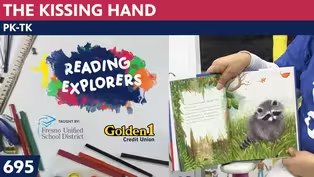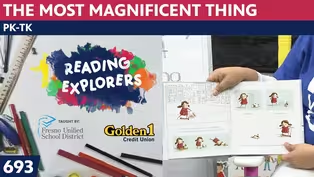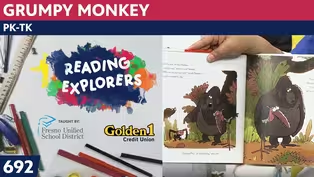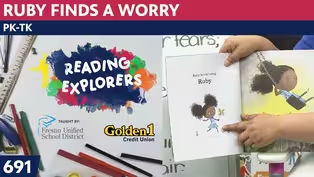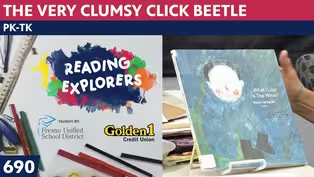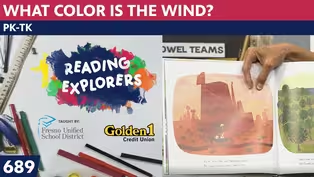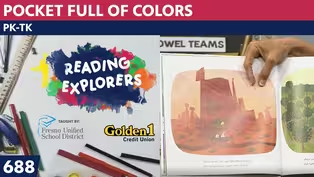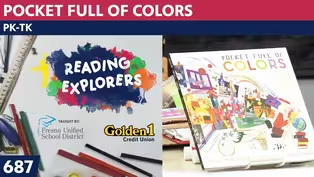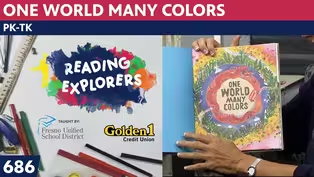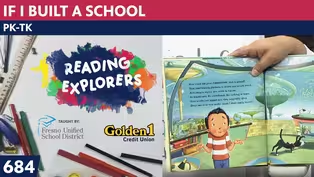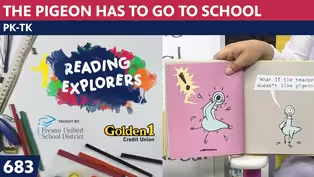
TK-380: Painting with scissors with Charley Harper
Season 3 Episode 451 | 14m 13sVideo has Closed Captions
Join Mrs. Readwright at Camp Discovery!
Transitional Kindergarten teacher, Mrs. Readwright, welcomes students back to Camp Discovery, a fun learning space packed with reading adventures & fun games!
Problems playing video? | Closed Captioning Feedback
Problems playing video? | Closed Captioning Feedback
Reading Explorers is a local public television program presented by Valley PBS

TK-380: Painting with scissors with Charley Harper
Season 3 Episode 451 | 14m 13sVideo has Closed Captions
Transitional Kindergarten teacher, Mrs. Readwright, welcomes students back to Camp Discovery, a fun learning space packed with reading adventures & fun games!
Problems playing video? | Closed Captioning Feedback
How to Watch Reading Explorers
Reading Explorers is available to stream on pbs.org and the free PBS App, available on iPhone, Apple TV, Android TV, Android smartphones, Amazon Fire TV, Amazon Fire Tablet, Roku, Samsung Smart TV, and Vizio.
Providing Support for PBS.org
Learn Moreabout PBS online sponsorshipMore from This Collection
Valley PBS and Fresno Unified School District have partnered with Golden 1 Credit Union to create Reading Explorers Lessons for grades Pre-Kindergarten through Third grade. The daily lessons will be taught by Fresno Unified School District teachers and are created to help students practice their reading skills and reinforce lessons during distance learning.
Video has Closed Captions
Valley PBS presents Reading Explorers Lessons for Pre-Kindergarten and TK. (26m 27s)
PK-TK-693-The Most Magnificent Thing
Video has Closed Captions
Valley PBS presents Reading Explorers Lessons for Pre-Kindergarten and TK. (26m 26s)
Video has Closed Captions
Valley PBS presents Reading Explorers Lessons for Pre-Kindergarten and TK. (26m 28s)
Video has Closed Captions
Valley PBS presents Reading Explorers Lessons for Pre-Kindergarten and TK. (26m 28s)
PK-TK-690: The Very Clumsy Click Beetle
Video has Closed Captions
Valley PBS presents Reading Explorers Lessons for Pre-Kindergarten and TK. (26m 22s)
PK-TK-689: What Color is the Wind?
Video has Closed Captions
Valley PBS presents Reading Explorers Lessons for Pre-Kindergarten and TK. (26m 21s)
PK-TK-688: Pocket Full of Colors
Video has Closed Captions
Valley PBS presents Reading Explorers Lessons for Pre-Kindergarten and TK. (25m 58s)
PK-TK-687: Dancing Through Fields of Colors
Video has Closed Captions
Valley PBS presents Reading Explorers Lessons for Pre-Kindergarten and TK. (26m 20s)
PK-TK-686: One World Many Colors
Video has Closed Captions
Valley PBS presents Reading Explorers Lessons for Pre-Kindergarten and TK. (27m 13s)
PK-TK-685: School is Wherever I am
Video has Closed Captions
Valley PBS presents Reading Explorers Lessons for Pre-Kindergarten and TK. (26m 32s)
PK-TK-684: If I Built a School
Video has Closed Captions
Valley PBS presents Reading Explorers Lessons for Pre-Kindergarten and TK. (26m 21s)
PK-TK-683: The Pigeon Has to Go to School
Video has Closed Captions
Valley PBS presents Reading Explorers Lessons for Pre-Kindergarten and TK. (26m 22s)
Providing Support for PBS.org
Learn Moreabout PBS online sponsorship♪ Good morning to a brand new day ♪ ♪ Time to learn and games to play ♪ ♪ Learning things is so much fun ♪ ♪ Learning is good for everyone ♪ (cheerful music) (playful music) - Hello, early learners.
And welcome back to the art room, where we are studying the art of Charley Harper.
Very simple art, lots of it we've been doing by cutting and pasting and adding a few decorations with our permanent pen.
And we've used the same materials all week long, which has been kind of fun to be able to just get better and better at it.
And I hope that after we go home on the weekend, that you'll try making more birds because next week we're going to do ones that are more scientific.
There were two artists that drew birds and people counted on them to make identification books where you can take the cards when you go on a trip in nature and think, wait, that one has mostly a gray body and a black head.
What is that bird?
And you can look at yours, the ones that we draw, that we find in our neighborhoods here and you can see if it looks like the one that you drew.
All right, let's start out with our hello song.
♪ Hello, nice to see you, everyone ♪ ♪ Hello, nice to see you, everyone ♪ ♪ Hello to you ♪ ♪ Hello to you ♪ ♪ Hello to you ♪ ♪ Hello to me ♪ ♪ Hello, nice to see you, everyone ♪ All right, Charley Harper.
He lived until he was 84 years old and did art all the way up until that time.
And his wife was an artist.
So, his house was full of art and he also loved nature.
He loved doing the artwork about animals and he sold a lot of his art to help nature conservancy, where they take care of animals in the wild and make sure that no one is destroying where they live.
So, we can talk about how the things we talked about at Earth Day and taking care of animals and not polluting the water or the places where they live.
So, let's all be super careful about wild animals, so that they continue to live on this earth just the way that we do.
Alrighty.
So, the song about the birds today.
These birds are called bluebirds, even though they have a lot of their body is red, but their wings are blue.
And when they flutter near the birdhouse that is in the picture, Charley Harper showed the movement kind of the way that Keith Haring did when we studied him and his people that were dancing.
We just put little movement lines on the outside of where they were moving.
Well, with these wings, we're going to do an outline of the wing, but then the wings are going to be acting like they're fluttering.
So, let's look at the song and see if we see what I'm talking about.
Ready?
♪ Which birds are these ♪ ♪ The bluebirds hear them sing ♪ ♪ As they approach the white birdhouse ♪ ♪ We see them flutter wings ♪ So, here it is.
This one has a red body with a white tail end with a blue kind of parallelogram as its tail.
Then here is its full wing outlined.
Then he has the feathers going up, up, up.
The wing, just an outline of it up here and then white ones for movement lines.
So, we'll see how much of that we get finished and you can see his leg comes out.
And Charley Harper often does three toes because most of the birds he draws has two toes in front and one in the back.
And the one in the back is for balance.
So, we'll see how we do this.
They have a little blue cap on their head, a pointy beak and a little tiny black eye.
So, we'll bring this down for our inspiration, get it on the little tabletop.
I'll move the things off my lap.
But let's see if I can find the sound for bluebirds.
They say the bluebird sound is number 64.
And this goes into the hundreds, 125.
So, I need to get all the way there to number 64.
And you know what happened the last few days, I've pushed it and it doesn't start.
(bluebird chirping) Yeah, it's the bluebird sound.
It's kind of a chirp, chirp and a tweet.
So, we'll see showing you this too, boys and girls, while I still remember.
If you are working on your art and you get a picture taken of yourself or the picture of your art, if you send it to the studio with your home address, you might get one of these.
Maybe not Arthur, maybe you'll get Pinkalicious or maybe Curious George.
He's so curious about what you're doing at home, so maybe it'll be him.
All right.
The table on my lap, my inspiration.
I decided to do blue background kind of the way that Charley Harper did.
I'll put that stuck up there.
I didn't plan to put a birdhouse on there but if you want to put one on there, it's really just a rectangle with a hole in the middle with a trapezoid roof and then another rectangle above where you'd hang it up on your tree or on the side of your house.
I have some dark blue, a couple of different shades.
This one was left in the sun.
You can see in my classroom where the sun came in and bleached it.
It took the blue out, the sun just kept beating on there.
And on this side you can see it's still blue.
So, we'll use that for some of the wings.
I cut this out just to get an idea if I was going to make the wings go up, up, up up, what I could do if I wanted to draw them or cut them out.
So, I wanted to see if that would help.
And it was kind of funny I noticed that the wing I cut, I didn't even measure it, but I did that.
I made it almost the same size.
Now, when I go to make his body, I'm gonna need to make it out a little bit more.
It's more of a half circle.
So, let's start that with our red paper.
And if I'm going to use this for the wing, I wanna make sure I make it a good size.
So, if you want to cut a wing out of a piece of paper for your template, you can do that before you start cutting.
Because all I'm going to do then is cut around its body or around the wings to make its body go back that way.
I think that looks pretty good.
I think it might be a little too big, but that's okay.
I'll move the red out of the way.
Oh, I better not, because I'm gonna need part of it for his face.
I'll just make his face be the cap, the part that's his cap.
So, I'll move it down enough like this and say, how far over do I want to go?
And it's almost right here to his back.
So, I'm gonna put his cap as a half circle.
I'm going to do that and make it go down a little bit so I can glue it.
So.
You'll see.
I'm going to cut across and cut up to make its little blue capped head.
And it's really another half circle like this.
I'll put the glue on it and move the body on top of that, so it has a place to rest its little head.
I'll move it to the end and put it on there.
Pretty good Mrs. Readwright.
Good thinking there.
I do have a little piece that's sticking out.
So, if that happens to you, if part of the face is too long for the edge, you can just cut it off.
There we go.
Now, I have the body of my bird.
I want this tail to go up and it comes out of its body where a little piece of white is on its bottom.
There are animals that have a little white on its bottom, like deer.
When I go to Yosemite and I see the deer, I think, oh, look at you.
When you were turned around backwards, you have a little white, it looks like it has white mittens on its bottom.
And you think, oh, that's just the way the deer's fur grows.
So, when I put this behind this bird and cut my white piece, I can then just glue it right on top.
It's just the right size.
So, I'll glue that, I put glue onto the tail.
Probably it would be better to put it on the blue, the white part, but I didn't.
So, I'm just gonna put this on here, so I can see where I want the tail to come out because it comes out of the white part just like that.
So, I will put it on here and then I can cut the tail.
So, I'm gonna put the glue where the white came out and put it on there and then I can trim it off.
So, you know this is not how I'm going to make the tail.
I just did that, so I could see how far to make it.
So, on this one, they just made the tail go straight up from the white part of the body, angle it in and go back down to the white part.
And you know, if you look at me doing this and you think, well, it looks so easy when she does it, it's because I tried it at home once before I came to see how long it would take to do this.
But also I've been cutting paper for many, many years.
Now, out of its place right here.
Let me show you.
Right below where its head meets, that's where the wing is going to come out.
And on the other side of its body would be another wing but I'm not going to show that.
And I'm going to find my little wing piece that I cut.
Here it is.
So, it's just going to be an outline, just like on here.
So, instead of it being a blue outline, I'm going to outline my template with black.
I'm gonna start it here, go down, go up and make the wing like this.
Just like this wing.
So, you can see I've got it so that I can then start making the feathers to make it flutter.
So, I'll do this.
I'll use this as my template.
Now watch, I want all of the wing feathers to be about the same size.
So, I'm going to fold this in half and in half again.
Watch what I do.
You can either draw it.
I brought a white pencil so I could see it on top of that.
And I can see how wide I wanna make it.
And I can make that.
I traced the top of it, and when it came down, I made it into a little point, like an eyebrow almost.
And then I can cut this.
If it's too thick for you and it hurts your hands to cut, just open it up and cut it over and over again.
I just have to go quickly because when the TV show is over, you think, now, how is she gonna make that?
So, I have to hurry and show you how, and then you can do it and take your time when you do yours.
So, let me glue this bird onto my blue paper, so I can show you how I'm going to make my wings.
Up around its head, under its chest, up to the tail to the end, on his back and in the middle, make it stick, stick, stick.
You can see I'm not really leaving very much room if I was to make a birdhouse.
So, I'm just going to add his feathers like this.
A little piece in between, so it will come down.
So, it looks like the wings are moving.
So, I'm going to put glue on this one and add it flying up, it's fluttering its wings.
Flutter means go very fast.
So, it's fluttering its wings because as they land, if they keep doing their full stroke of their wings moving, it would crash them into the birdhouse.
So, he has to flutter to slow himself down to get there.
So, now I'm going to put these fluttering wings on, and I think that's enough.
I think three is good for me.
Now, I would like to put its black eye on with my black pen.
Let me look at my inspiration and put it.
It goes right below where the blue attaches and right below that is its little pointed beak.
So, I can do that.
I want to be sure to put its two legs flying forward.
So, this one with the toe in back and two in front.
And this one, toe in back and two in front.
Boys and girls, it's been a great week of doing bird study with you.
Thank you for joining me and doing the art with me.
And remember, you can go back and work, add a little bit more.
I might add some white feathers on here.
So, it's been great being with you and we will sing goodbye to one another.
♪ Goodbye, see you next time, everyone ♪ ♪ Goodbye, see you next time, everyone ♪ ♪ Goodbye to you ♪ ♪ Goodbye to you ♪ See you on Monday, boys and girls.
(cheerful music) ♪ Good morning to a brand new day ♪ ♪ Time to learn and games to play ♪ ♪ Learning things is so much fun ♪ ♪ Learning is good for everyone ♪ (cheerful music)
Support for PBS provided by:
Reading Explorers is a local public television program presented by Valley PBS
